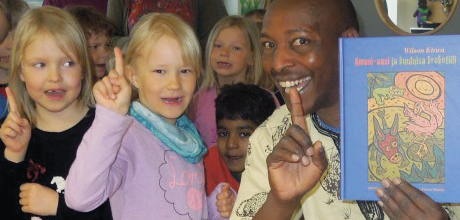Pedagogical practices supporting multi-literacy provided by Lukuinto pilot project results

Evaluation of the pilot projects highlights changes and functions recurring at various sites, which have promoted the steering of multi-literacy. The analysis includes quotations from the pilot project participants.
- Cooperation
- Learner orientation
- Functionality
- More efficient use of information and communication technologies
- Moulding and expanding the learning environment
The evaluation reports of the pilot project participants clearly show that they have boldly started off to answer the challenges provided by the pedagogics of new literacy skills. Fast-changing technological environment in particular requires that pedagogical practices be developed to correspond with contemporary needs. The pedagogics of multi-literacy utilise technology in learning, in other words the environment in which the children have grown.
The pilot project participants reported that they had changed pedagogical practices to be more collaborative, learner-oriented and functional, as well as to utilise information and communication technology more efficiently. The learning environment was also moulded and expanded.
Key to cooperation is that the work takes place in small groups, peer learning is utilised and responsibility for the common goal is shouldered.
The point of departure of learner orientation is the pupils' own expertise, as well as objects of interest and the everyday life in which they live. Learner orientation means that pupils can make choices that support their learning processes. This makes learning meaningful. Learner orientation also means increased freedom while simultaneously making pupils more responsible and including them in the planning of activities.
Functionality activates pupils to hone their reading skills by acting; moving, empathising, studying the environment and producing new interpretations about the book read, for example. This gives pupils an active role. During the pilot projects, reading skills have been honed, in addition to traditional reading and writing skills, both through various forms of information and media literacy (for example, text, video, audio, drama and theatre and cinema).
Giving technology an increasingly large role in teaching expands the learning environment and motivates pupils, because they get to use devices that are natural and inspiring to them in learning new things. Varied learning environments in teaching support pupils' multi-literacy skills. Characteristics of a learning environment supporting multi-literacy skills include openness and expansion of the environment outside the school to home, library and the rest of the environment as well as society. High quality learning environment enables functionality. Learning environment feeds cooperative operating culture. Physical environment enables learning together and teaching. The most significant dimension of the learning environment is a communal operating culture, which is immaterial, flexible and changes over time.
The pilot project participants used mostly desktop, laptop and tablet PCs in their teaching. Technology was utilised in a variety of ways: information retrieval, text production, learning games, photography, video-making and editing. The pilot project participants assessed that the utilisation of technology promoted more than before the honing of multi-literacy and expanded the learning environment.
The learning environment was also concretely expanded outside the school especially to libraries, the surroundings and children's leisure time activities. Library facilities are used more and more flexibly than before as teaching and learning facilities. For example, one project focused on finding new ways for the school and the library to cooperate especially in the utilisation of facilities. If the school was only served by a travelling library, the schedule and the length of stay were adjusted to better comply with the need. The school premises were also altered to better support reading. For example, reading nooks were constructed in classrooms or school premises were named after literature.
Pupils' free time was also utilised as a learning environment and skills learnt during their leisure time as well as their interests were used in the form of learning games and gaming in particular.
In two development projects, reading dogs were utilised to support reading. Utilisation of a pet, a living creature, in learning reading skills makes the learning environment more varied while motivating and calming the reading moment. Pedagogical practices supporting multi-literacy, break/remove earlier barriers, or change them.
What should be taken into account in pedagogical practices supporting multi-literacy:
- Pupils must be provided with sufficient support and guidelines
- Pupils must have clear responsibilities and roles
- All areas of multi-literacy do not have to be taught, since learner-oriented multi-literacy means that pupils select the forms most appealing to them.
- Yet, it must simultaneously be ensured that traditional skills are sufficiently honed in addition to opportunities afforded by the new technological environment (for example, manual skills, sufficient physical exercise, use of memory and practise)
- It must be ensured that there is a sufficient knowledge basis and a possibility to practise skills
- More flexible premises enable both individual and communal learning
- Practising concentration and persistence, for example, reading a whole work
- A special challenge is linking the new with the traditional; what to remove from the traditional? What deserves to go? What to replace it with?




